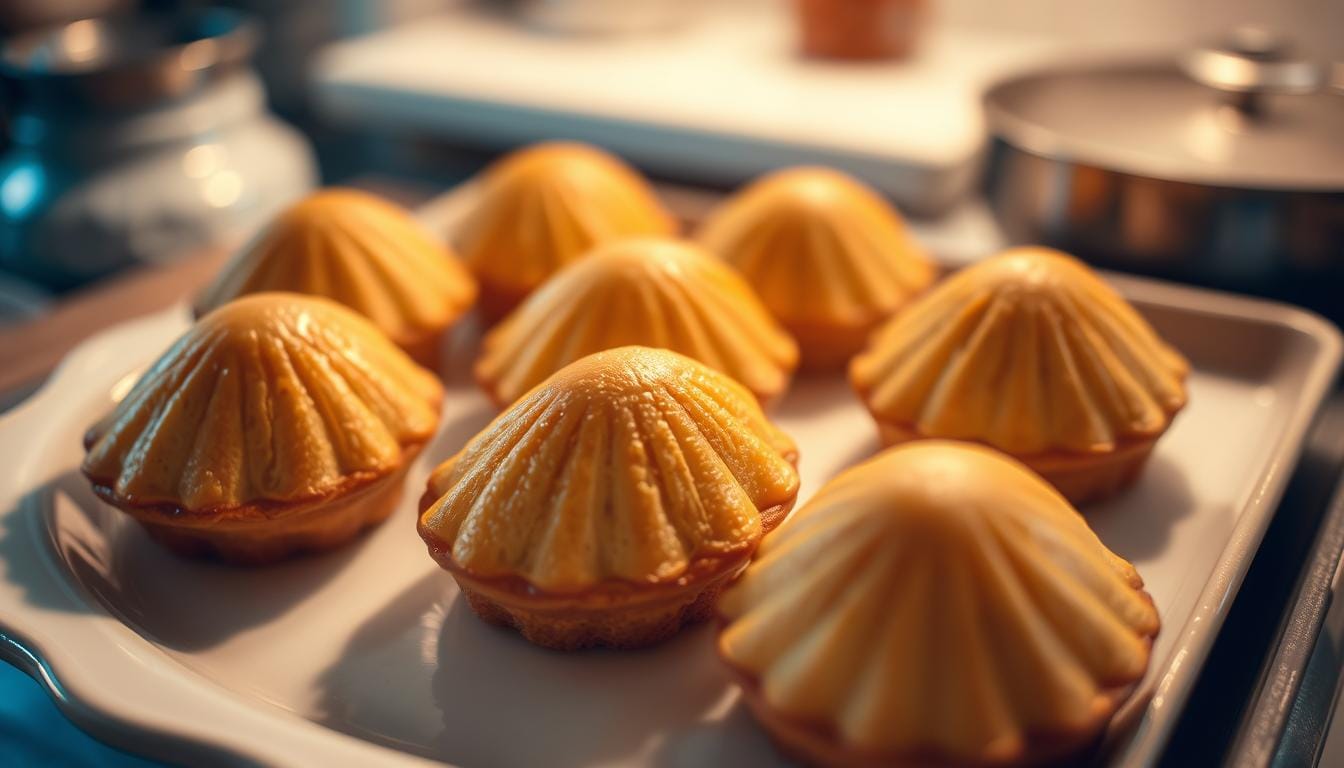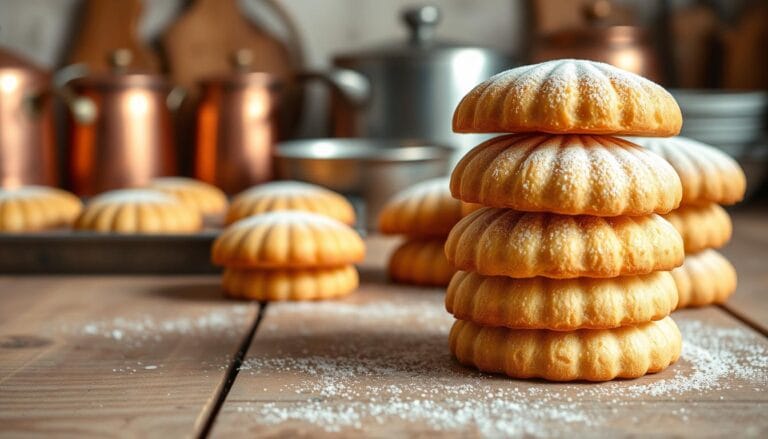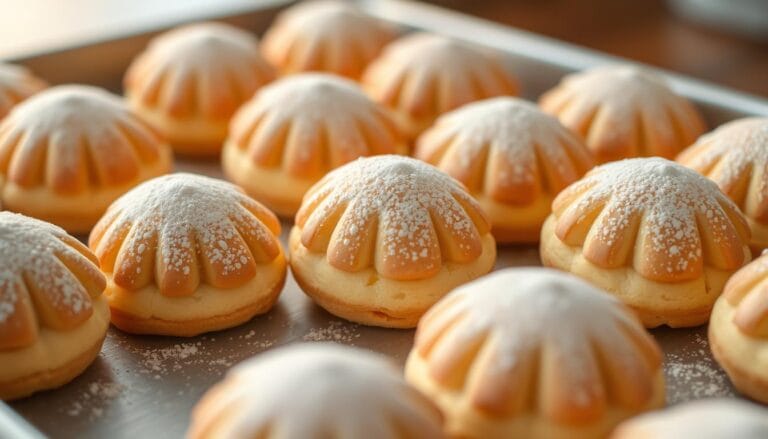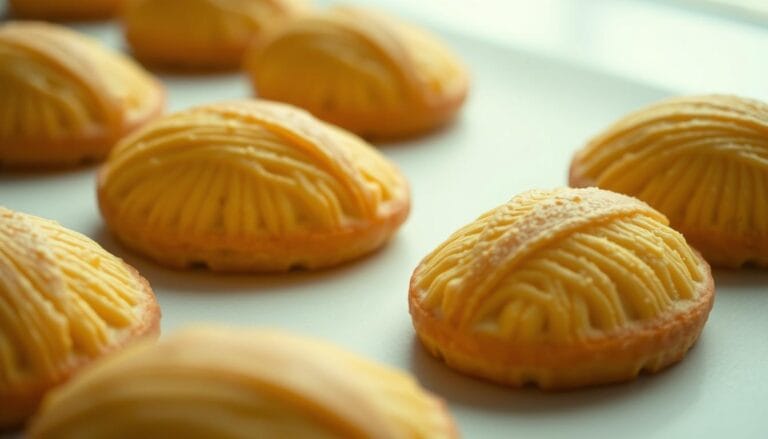Classic Madeleine Cookies Recipe
Explore the world of French pastries with madeleines cookies. These delicate, shell-shaped cakes are a true reflection of French culinary art. They offer a unique blend of cookie and cake, making your baking a special experience.
Madeleines come from France and are more than just cookies. They are a tradition that adds elegance to your desserts. Their distinctive shape and soft texture make them perfect for any time of day.
This recipe will teach you to make authentic French madeleines. They are light, buttery, and hard to resist. Whether you’re new to baking or a seasoned pastry chef, these steps will help you achieve madeleine perfection.
Table of Contents
Understanding French Madeleines: Between Cookies and Cakes
Explore the magical world of madeleines, those delightful buttery sponge cakes. They are a mix of cookies and pastries. These treats come from the Lorraine region and have won hearts all over the world.
The story of madeleines is as rich as their texture. Their history is deep and fascinating, beyond just baking.
The Origin of Shell-Shaped Delicacies
In the beautiful Lorraine region of France, madeleines were born. They are special because of their unique shape and taste:
- Distinctive shell-like shape
- Light and airy texture
- Delicate buttery flavor
- Perfectly sized for a single bite
Traditional Characteristics of Madeleines
These cakes are more than a sweet treat. They show a perfect mix of ingredients and skill. Bakers work hard to make each madeleine just right:
- Golden-brown exterior
- Soft, springy interior
- Subtle hint of vanilla or citrus
The Proust Connection
“The taste of the little madeleine brings me back to my childhood…”
Proust’s madeleine became famous, turning simple cakes into symbols of memory and nostalgia. In his novel, a madeleine brings back childhood memories. This made the pastry a key part of French culture.
Enjoyed with tea or as a quick snack, madeleines still charm food lovers. They have a timeless appeal and a rich history.
Essential Equipment and Ingredients for Perfect Madeleines
To make authentic madeleines, you need the right tools and ingredients. These French treats require specific equipment and high-quality ingredients. This ensures they have their signature shell shape and soft texture.
Start your madeleine baking journey by getting the right ingredients. Here’s what you’ll need:
- Butter: 113g (½ cup) of high-quality unsalted butter
- Eggs: 100g (2 large eggs) at room temperature
- Sugar: 100g (½ cup) fine granulated sugar
- Flour: 115g (½ cup + 1 tbsp) all-purpose or pastry flour
- Lemon Zest: 5g (about 1 tbsp) for bright, citrusy notes
The madeleine pan is crucial for baking. These special molds give the cookies their iconic shape. Choose non-stick pans with deep, well-defined shell imprints for the best results.
Other important ingredients include:
- Baking powder (7g or 1½ tsp) for light, airy texture
- Salt (2g or ¼ tsp) to enhance flavor
- Vanilla extract for depth and aroma
Choose fresh and high-quality ingredients. Using room-temperature eggs and butter will make your madeleines tender and flavorful.
The Art of Brown Butter (Beurre Noisette) in Madeleines
Turning regular butter into a special ingredient is key to making French pastries stand out. Beurre noisette, or brown butter, makes madeleines truly special. It adds a rich, nutty taste that’s hard to beat.
Making brown butter for your French pastries brings out a unique flavor. This simple yet magical process makes your madeleines unforgettable.
Mastering Brown Butter Technique
To make perfect beurre noisette, follow these steps:
- Use unsalted butter at room temperature
- Choose a light-colored pan for precise color monitoring
- Melt butter over medium-low heat
- Watch for milk solids to turn golden brown
- Listen for a subtle nutty aroma
Flavor Enhancement Secrets
Brown butter gives madeleines a complex, toasted flavor that regular melted butter can’t match. The Maillard reaction during browning creates special taste molecules. These molecules add warmth and depth to your French pastries.
Experts say to let the brown butter cool a bit before mixing it into your madeleine batter. This keeps the batter’s texture right while keeping the brown butter’s rich flavor.
Mastering the Madeleine Cookies Technique
Making perfect madeleines cookies needs precision and respect for old baking ways. Your path to becoming a pro starts with learning the art of preparation.
The secret to great madeleines is in how you handle ingredients and technique. French baking traditions teach us the importance of every step in making these shell-shaped treats.
- Cream eggs and sugar until light and fluffy
- Gently fold flour to maintain batter structure
- Chill batter for optimal texture
- Use proper mixing techniques
When baking madeleines, temperature and technique are key. Let your batter chill in the fridge for at least 2 hours. This lets flavors meld and gives the right texture.
| Technique | Key Consideration |
|---|---|
| Egg Creaming | Beat until pale and voluminous |
| Flour Incorporation | Fold gently to preserve air |
| Batter Resting | Refrigerate 2+ hours |
Professional bakers say madeleines cookies need careful attention. Make sure your baking pan is well-prepared. Butter each shell-shaped cavity well for perfect release and a beautiful look.
The secret to magnificent madeleines lies in respecting traditional baking methods and understanding the delicate balance of ingredients.
With practice and patience, your baking will improve. You’ll make madeleines that honor French culinary traditions with every bite.
Critical Steps for Light and Fluffy Texture
Making perfect buttery sponge cakes needs precision and care. French pastries like madeleines require special techniques for their light texture. Knowing these steps will help you make these delicate treats.
Room Temperature Ingredients Matter
Temperature is key for making tasty madeleines. Make sure all ingredients are at room temperature, especially eggs. Here’s why:
- Room temperature eggs blend more smoothly
- Ingredients incorporate more evenly
- Helps create a consistent batter texture
Mixing Methods for Perfect Texture
Right mixing is vital for that classic madeleine texture. Follow these guidelines:
- Whisk eggs and sugar on high speed for 10 minutes
- Look for the ribbon stage when batter falls slowly from the beater
- Sift flour over the batter in 2 gentle additions
- Avoid overmixing to prevent tough cookies
Resting the Batter: A Critical Step
Chilling your madeleine batter is key for flavor and texture. Follow these tips:
- Refrigerate batter for at least 2 hours
- Let batter sit at room temperature for 10 minutes before baking
- Do not chill longer than 24 hours
By following these steps, you’ll make French pastries with a light, buttery sponge cake texture. Remember, practice makes perfect!
Preparing Your Madeleine Pan for Baking
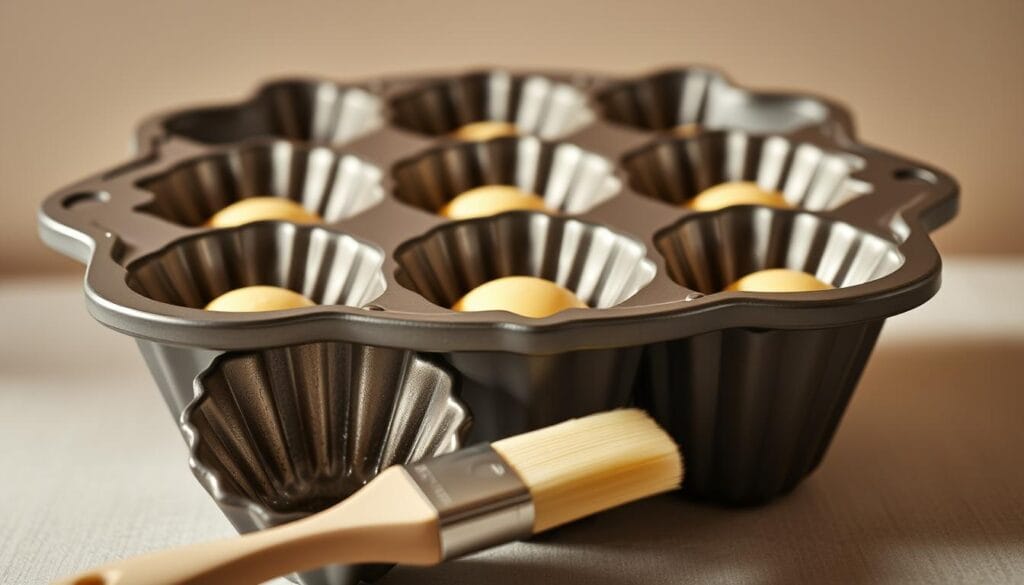
Making perfect shell-shaped cakes starts with preparing your pan well. Your madeleine pan is key to getting those iconic, delicate shapes. These are a big part of French baking traditions.
Choosing the right pan is very important. You have two main options:
- Traditional metal madeleine pans with distinctive shell-shaped molds
- Non-stick silicone pans for easier release
Greasing your pan needs careful attention. Pro baking tip: Use unsalted butter to coat every part of the molds. This helps your cakes come out smoothly without sticking.
Here are the key steps for pan preparation:
- Generously brush each mold with softened butter
- Dust lightly with flour, tapping out excess
- Refrigerate the greased pan for 10 minutes before adding batter
When using metal pans, make sure to coat the shell-shaped impressions well. Baking traditions require precision. A well-prepared pan is essential for beautiful madeleines.
Remember: A perfectly prepared pan is the first step to creating those legendary French delicacies!
Perfect Timing and Temperature Guidelines
Baking madeleines cookies needs precision and careful attention. These French pastries require a specific approach. This is to achieve their light texture and iconic hump.
Mastering the baking process for madeleines involves understanding key temperature and timing details:
- Initial baking temperature: 460°F (240°C) for first 5 minutes
- Reduced temperature: 350°F (180°C) for additional 5-7 minutes
- Total baking time: 10-12 minutes
Signs of Proper Baking
When baking madeleines cookies, look for these critical indicators of perfect doneness:
- Golden edges with a light, delicate coloration
- Springy texture when gently pressed
- Distinctive shell-like shape with a prominent hump
- Slight resistance when touched
Achieving the Signature Hump
The characteristic hump of French pastries like madeleines requires strategic preparation. Refrigerate your batter for 15-30 minutes before baking. This chilling process helps create the iconic bump by shocking the batter when it hits the hot oven.
Fill each madeleine mold only 3/4 full to prevent overflow and ensure proper hump formation. Your attention to these details will transform your homemade madeleines from ordinary to extraordinary.
Classic French Finishing Touches
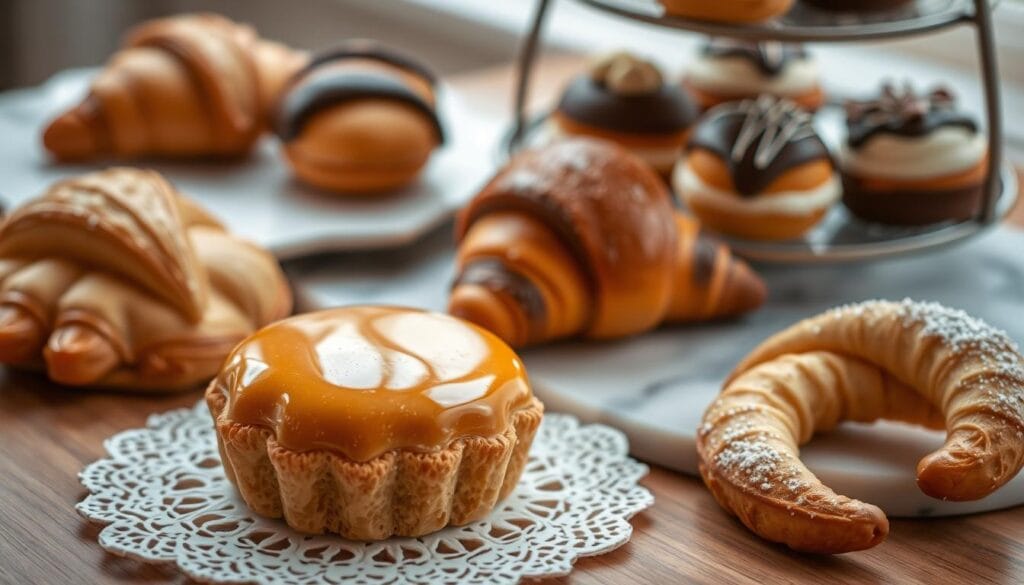
Turn your homemade madeleines into stunning French pastries with elegant touches. These small cakes can become true culinary art. The final presentation makes all the difference.
Traditional finishing methods for madeleines include several delightful techniques:
- Dusting with confectioners’ sugar (2.11 ounces)
- Dipping in rich melted chocolate
- Drizzling with light lemon glaze (1.5-2 tablespoons juice)
- Creating decorative chocolate patterns
When preparing your gâteau de voyage, consider these professional finishing tips:
- Ensure madeleines are completely cooled before decorating
- Use a fine-mesh sieve for even powdered sugar distribution
- Melt chocolate at precisely 500°F for smooth coating
- Allow glazes to set for 1-3 minutes before serving
*”The beauty of a madeleine lies not just in its taste, but in its elegant presentation”* – French Pastry Tradition
Your finished madeleines can be stored in an airtight container for up to 2 days. They will keep their delicate texture and look. Whether for a picnic, tea time, or as a sophisticated dessert, these touches will make your madeleines a true French delicacy.
Storage Tips and Serving Suggestions
Making perfect buttery sponge cakes like madeleines needs skill and knowing how to keep them fresh. The right storage and serving tips will help keep their texture and taste great.
Your freshly baked madeleines are best eaten within a few hours. To keep them delicious, follow these expert tips:
Best Serving Temperature
Madeleines taste best when slightly warm. This temperature brings out their buttery aroma. Here’s how to serve them:
- Serve right after baking for the best texture
- Warm them in an oven at 300°F for 2-3 minutes if they’ve cooled
- Don’t microwave them, as it can make them tough
Storage Recommendations
While madeleines are best fresh, you can keep them longer with the right storage:
| Storage Method | Duration | Preservation Tips |
|---|---|---|
| Room Temperature | 2-3 days | Use airtight container |
| Refrigerator | Up to 5 days | Store in sealed container |
| Freezer | Up to 3 months | Wrap individually in plastic wrap |
Pairing Recommendations
These French pastries go well with many drinks and foods:
- Classic Pairings: Earl Grey tea, espresso
- Dessert Companions: Lemon curd, raspberry jam
- Beverage Options: Chamomile tea, hot chocolate
Each madeleine has about 109 calories. They offer a moment of joy in French baking. Enjoy them slowly and appreciate the traditional baking art.
Common Mistakes to Avoid
Baking madeleines cookies is a precise art. Many bakers struggle with keeping the cookies light and with their classic shape. One big mistake is overmixing the batter. This can make your madeleines dense and tough.
Getting the temperature and ingredients right is key. Cold ingredients can cause the mix to separate. Also, using expired leavening agents can lead to flat cookies. Use room-temperature eggs and butter, check expiration dates, and measure ingredients carefully. Remember, flour from the bag can be up to 25% more than what’s called for.
How you bake is just as important. Don’t overcrowd your baking sheet. This can cause uneven baking and ruin the cookie’s shape. Also, start with a cold oven and check the temperature. Baking at 375°F for 10-12 minutes is usually best. This ensures a golden-brown exterior, just like in traditional French baking.
Mastering madeleine baking is your goal. By avoiding common mistakes and using careful technique, you’ll make your kitchen a French pastry paradise. Each batch brings you closer to making those light, buttery madeleines that have been loved for generations.
FAQ
What exactly are madeleines?
Why are madeleines associated with Marcel Proust?
Do I need a special pan to make madeleines?
What is beurre noisette, and why is it important in madeleine recipes?
How do I achieve the signature hump on my madeleines?
How long do madeleines stay fresh?
Can I add different flavors to my madeleines?
What are the most common mistakes when making madeleines?
Source Links
- Classic French Madeleines – Baker by Nature – https://bakerbynature.com/classic-french-madeleines/
- How to Make Classic Madeleines – https://foodnouveau.com/classic-madeleines/
- How to Perfect the Madeleine Cookie Recipe – A Beginner’s Guide – Madeleine Kitchen – https://www.madeleinekitchen.com/madeleine-cookie-recipe/
- Madeleines Are The Easiest French Dessert To Bake – https://www.delish.com/cooking/recipe-ideas/a41004403/french-madeleines-recipe/
- Madeleines Recipe: How to Make French Butter Cakes – Mon Petit Four – https://www.monpetitfour.com/madeleines-recipe/
- A Recipe that Works! – Weekend Bakery – https://www.weekendbakery.com/posts/madeleines-a-recipe-that-works/
- How To Make Perfect Lemon Madeleines – Light, Fluffy & Buttery. | Matthew James Duffy – https://matthewjamesduffy.com/how-to-make-lemon-madeleines/
- Madeleines – https://www.tasteofhome.com/recipes/madeleines-recipe/?srsltid=AfmBOoom0Cmo-UgUq1SreEeZK5kOjBvvi2q_msUzt5965Z4lE3uRFtUj
- How to Make Easy, Perfect Pumpkin Madeleines | Most Lovely Things – https://mostlovelythings.com/small-batch-pumpkin-madeleines-recipe/
- The many lives of a madeleine – https://agoodtable.substack.com/p/the-many-lives-of-a-madeleine
- The Essential Gluten Free Guide to France – https://www.legalnomads.com/gluten-free/france/
- Madeleines — French Cooking Academy – https://www.thefrenchcookingacademy.com/recipes/madeleines
- The Madeleine: A Petite French Pastry with Big Charm – https://zeroinacademy.com/the-madeleine-a-petite-french-pastry-with-big-charm/
- Madeline Cookies Recipe Using Cream: 7 Secrets for Soft & Buttery Perfection – https://www.amuserecipes.com/madeline-cookies-recipe-using-cream-7-secrets-for-soft-buttery-perfection/
- Our Madeleine Recipe Includes the Classic and 8 Variations – https://www.marthastewart.com/856115/vanilla-madeleines
- Madeleines – https://www.tasteofhome.com/recipes/madeleines-recipe/?srsltid=AfmBOoqGPq2_psQHJxIkGQdvrcXoAD5sG0cElee0zEvYjIPK4xGY9aQ5
- Perfect Madeleines — Oh Cakes Winnie – https://www.ohcakeswinnie.com/blog/perfect-madeleine
- Lemon Madeleine Recipe • easy & authentic! – https://theviewfromgreatisland.com/lemon-madeleine-recipe/
- Madeleines – https://www.tasteofhome.com/recipes/madeleines-recipe/?srsltid=AfmBOopkmtIT57a5JSGakXQprz71U_G0cod16u2InT8AUSfm3-cTdpgx
- Madeleines (Classic French Recipe) – https://www.sweetashoney.co/madeleine-recipe/
- Classic Glazed Lemon Madeleines – https://pudgefactor.com/lemon-madeleines/
- Madeleines – https://www.tasteofhome.com/recipes/madeleines-recipe/?srsltid=AfmBOop_sw1MENwoSlboBE61wek2wC-L3gx2c91gZqc-_0sks5avmQUS
- Madeleine Cookies – https://www.africanbites.com/coconut-almond-madeleines/
- Brown Butter Madeleines – https://www.vanillabeancuisine.com/brown-butter-madeleines/
- Madeleines – https://www.tasteofhome.com/recipes/madeleines-recipe/?srsltid=AfmBOooM1GNymFMnbT40xCoNzr5JbLnz37BBRoTB70wQvpXx4boa2cG2
- 16 Common Baking Mistakes That Are Ruining Your Cookies – Chowhound – https://www.chowhound.com/1764872/common-cookie-baking-mistakes/
- Traditional Madeleine recipe How to Make Perfect French Cookies Every Time – awerecipes.com – https://awerecipes.com/choosing-the-right-madeleine-pan-materials-impact/

